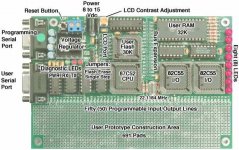emptymind
Member
I would check pinout and some more documents/discussions before swapping chips.
Emptymind early on posted a picture of the motherboard. It looks identical to the 3032 boards I have, with four large chips: 6502, 6520, 6520, 6522 so you're probably right it has no 6545 chip, my fault. On the other hand it means I could test-drive some of my last spare boards, in order to diagnose which are still good to go. If no progress is made on his board then there would exist an alternative branch.
Thanks Anders.
Quick Update:
When I opened up the C64 it turned out it was actually a C64C with the 8500 chip (I think this is basically a 6502 with a different pin layout) and in any case it's soldered. I do have a working BBC Model B though, and I'm pretty certain it has a removable 6502. If it does it might be worth me swapping it just in case? If that doesn't work then I'm down to checking the ROMS. If I can't find any way of reading them I might have to send them to one of you guys if anyone is willing to check them? Or borrow some from harry.
Thanks guys!

